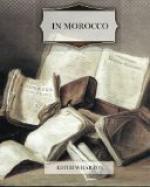Until a year or two ago these collegiate buildings were as inaccessible as the mosques, but now that the French government has undertaken their restoration strangers may visit them under the guidance of the Fine Arts Department.
All are built on the same plan, the plan of Sale and Rabat, which (as M. Tranchant de Lunel[A] has pointed out) became, with slight modifications, that of the rich private houses of Morocco. But interesting as they are in plan and the application of ornament, their main beauty lies in their details, in the union of chiselled plaster with the delicate mosaic work of niches and revetements, the web-like arabesques of the upper walls and the bold, almost Gothic sculpture of the cedar architraves and corbels supporting them. And when all these details are enumerated, and also the fretted panels of cedar, the bronze doors with their great shield-like bosses, and the honeycombings and rufflings of the gilded ceilings, there still remains the general tinge of dry disintegration, as though all were perishing of a desert fever—that, and the final wonder of seeing before one, in such a setting, the continuance of the very life that went on there when the tiles were set and the gold was new on the ceilings.
[Footnote A: In France-Maroc, No. 1.]
For these tottering Medersas, already in the hands of the restorers, are still inhabited. As long as the stairway holds and the balcony has not rotted from its corbels, the students of the University see no reason for abandoning their lodgings above the cool fountain and the house of prayer. The strange men giving incomprehensible orders for unnecessary repairs need not disturb their meditations, and when the hammering grows too loud the oulamas have only to pass through the silk market or the souk of the embroiderers to the mosque of Kairouiyin, and go on weaving the pattern of their dreams by the fountain of perfect bliss.
One reads of the bazaars of Fez that they have been for centuries the central market of the country. Here are to be found not only the silks and pottery, the Jewish goldsmiths’ work, the arms and embroidered saddlery which the city itself produces, but “morocco” from Marrakech, rugs, tent-hangings and matting from Rabat and Sale, grain baskets from Moulay Idriss, daggers from the Souss, and whatever European wares the native markets consume. One looks, on the plan of Fez, at the space covered by the bazaars, one breasts the swarms that pour through them from dawn to dusk—and one remains perplexed, disappointed. They are less “Oriental” than one had expected, if “Oriental” means color and gaiety.
Sometimes, on occasion, it does mean that: as, for instance, when a procession passes bearing the gifts for a Jewish wedding. The gray crowd makes way for a group of musicians in brilliant caftans, and following them comes a long file of women with uncovered faces and bejewelled necks, balancing on their heads the dishes the guests have sent to the feast—kouskous, sweet creams and syrups, “gazelles’ horns” of sugar and almonds—in delicately woven baskets, each covered with several squares of bright gauze edged with gold. Then one remembers the marketing of the Lady of “The Three Calendars,” and Fez again becomes the Bagdad of Al Raschid.




